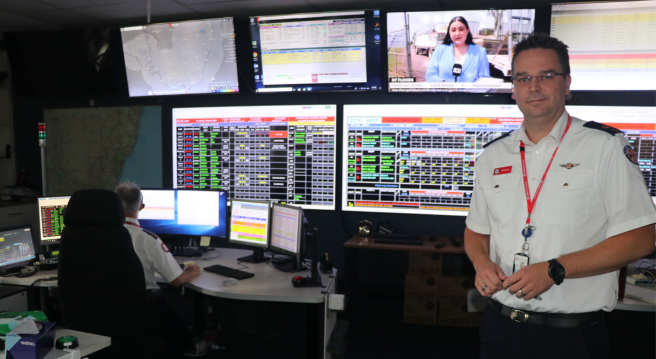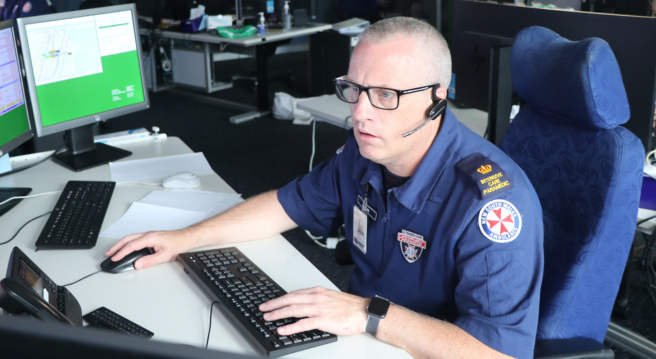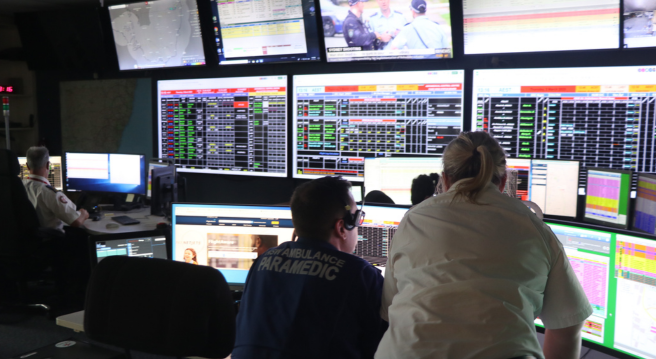
Aeromedical Control Centre Manager David Lilly (right) on the Aeromedical Control Centre floor
On the second floor of the Sydney Ambulance Centre at Eveleigh is NSW Ambulance’s own ”air traffic control tower“ – the Aeromedical Control Centre (ACC).
Passing through a door at the end of a corridor of offices, you enter a large open plan space about 20 metres square. The front wall of the room is covered with flatscreens, with one screen tuned to ABC News 24. Around 10 uniformed staff – some sitting, some standing – hover intently over banks of monitors at their workstations.
Duty Aeromedical Manager Andrew McDougall sits at the back of the room. “From here, we control all NSW Ambulance aviation resources, operating 24/7,” Andrew explained. “That includes fixed wing, helicopters and road retrieval resources.”
(Note: Aeromedical teams, made up of a Critical Care Doctor and a Critical Care paramedic are often dispatched to major incidents by road in metropolitan areas.)
“On the right side of the room are the fixed wing planners. They’re our day shift planners who start from 0600 and work to 1800. Then there’s night shift from 1800 to 0600 and the middle desk is 1000 to 2200. On the left side of the room we have helicopter planners or Rapid Launch Trauma Coordinators (RLTC). There’s a day shift and an afternoon shift. Behind them is our Clinical Coordinator, a critical care nurse, and in the back corner is the State Retrieval Consultant for NSW.”
The flight planners or Aeromedical Control Centre Officers (ACCOs) are paramedics with a minimum of five years’ experience. As part of the job, ACCOs undergo additional training for medical and aviation environments and have to maintain currency in these certifications. The nurses and doctors come mostly from emergency department backgrounds.

At the RLTC desk, Linda Reichstadter has worked through the busiest times since starting at the ACC in 2000. The response to the floods in Eugowra in the Central West of NSW last November was one of the most intense in recent memory. NSW Ambulance helicopters were over Eugowra within an hour as floodwaters rushed through the town.
“I was working as an educator that day, and they brought me back to work on the desk in a surge capacity,” Linda told Sirens. “I was reading jobs about houses floating away with old people in them... We were getting calls from helicopter paramedics asking us to source cutting tools to free nine people trapped in a roof cavity. I ended up working as a Liaison Officer as part of the Aeromedical Interagency Coordination Cell (AICC) on the air desk at the Rural Fire Service State Operations Centre with the Police Air Wing and others, coordinating air assets.”
The assets the ACC coordinates include aircraft at three fixed wing bases at Mascot, Dubbo and Broken Hill, nine helicopter bases, road retrieval ambulances at the helicopter bases, the aircrew (pilots and aircrew men and women) who fly the aircraft and operate the winch, the Helicopter and Road Retrieval Critical Care Paramedics, Flight Nurses and Specialist Doctors on board.
Green lights at each workstation in the ACC are illuminated as ACCOs pick up the phone. One ACCO took a call from a rural Local Health District looking to airlift a patient with a threatened limb via fixed wing to Sydney.
“I plan the flights and the road legs around them,” she explained. “We all work together to assess each patient’s clinical need to ensure they get the best possible care.”

This flight planning process requires taking numerous factors into consideration. Factors such as the weather conditions, crew availability and budgeting rest periods for pilots to meet strict Civil Aviation Safety Authority (CASA) guidelines.
The ACCO escalated the job to the State Retrieval Consultant to consult directly with the doctor at the LHD. The State Retrieval Consultant then upgraded the job to Priority 1. In total, there are just over 40 ACC staff and 25 State Retrieval Consultants (the latter working fractional hours).
For ACC Manager David Lilly, the highlight of the work is the good patient outcomes.
“When you can see somebody that is in obvious peril, and with our timely interventions, you can get them to appropriate care in the appropriate time,” David said. “People‘s locations limit their ability to access critical care, but because of the big aeromedical assets we have, we can take the critical care to them.”
In January 2022, NSW Ambulance began a contract with aviation provider Pel-Air that included five new Beechcraft King Air 350C planes that transport more than 6,000 patients a year.
When asked about the attraction of ACC work David cited new challenges every time staff come to work.
“Whether you’re responding to floods or fires or to people affected through the pandemic the job is always changing and evolving. It’s not the kind of job you just come to and it’s the same thing day after day. You always have to step up.
“It’s also great to see people walk in the door completely overwhelmed with the steep learning curve ahead of them, and after they have some confidence, get comfortable in their roles and progress their careers,” David said.
